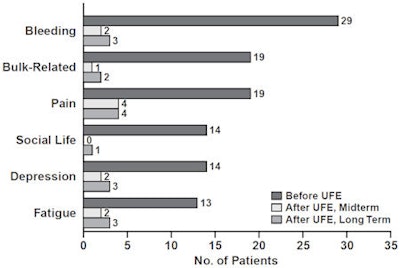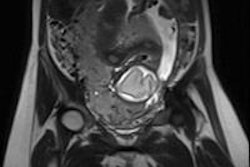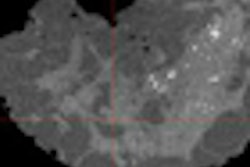
Uterine fibroid embolization (UFE) provides long-term relief for a variety of fibroid symptoms, according to a study by Austrian researchers to be published in the July issue of the American Journal of Roentgenology.
Dr. Martin Popovic and colleagues at the Medical University of Vienna conducted a study to assess long-term quality of life among patients who had undergone UFE (AJR, July 2009, Vol. 193:1, pp. 267-271). Thirty-nine of 53 women who had undergone UFE in 2004 and had responded to a previous quality-of-life assessment in 2006 participated.
The researchers used a questionnaire that included 49 questions on six topics:
- Baseline characteristics
- Status before intervention
- Diagnostic evaluation and treatment planning
- Peri-interventional period and procedure-related quality of life
- Follow-up
- General satisfaction
The median follow-up period from the UFE procedure was seven years, and the mean age of the patients was 49 (range, 35 to 66). The most important reasons indicated for choosing UFE were:
- Preservation of the uterus (34 patients)
- Desire for children (four patients)
- Fear of surgery (one patient)
Six of the women ended up having hysterectomies -- two underwent the procedure a year after UFE, and of the remaining four, one patient each underwent the procedure 2.1, 2.9, 3.3, and 5.7 years after UFE. Popovic and colleagues excluded these six women from subsequent statistical analysis.
UFE led to a reduction of bleeding symptoms in 89.7% of the patients, pain in 78.9%, bulk-related symptoms in 89.5%, fatigue in 76.9%, limitations to social life in 92.9%, and depression in 78.6%. After UFE, two women gave birth to healthy infants at term, four women continued to have trouble conceiving, and one had a miscarriage. Five women had amenorrhea; four of the five were older than 50, and one patient was 42 at follow-up.
 |
| Graph shows developments from before UFE through midterm and long-term follow-up (n = 33). Image courtesy of the American Roentgen Ray Society. |
Median impairment scores for bleeding and pain decreased compared to the 2006 assessment, from 7 to 0 and 5 to 0, respectively. General quality-of-life scores increased from 4.5 to 9. Thirty-two of the participating patients, or 82.1%, were satisfied with the UFE procedure, and 30 of the women, or 76.9%, said they would recommend it to other women.
"We conclude that UFE seems to significantly improve women's health-related quality of life and appears to lead to impressive long-term relief of physical and psychologic leiomyoma-associated symptoms and improvement in well-being," the authors wrote.
By Kate Madden Yee
AuntMinnie.com staff writer
June 30, 2009
Related Reading
SIR study: Women not told of UFE option, March 19, 2008
Both UFE, hysterectomy improve quality of life, February 20, 2008
Fibroid embolization is safe, effective long-term, January 21, 2008
UFE without standard aortography cuts radiation dose, May 18, 2007
ISET talks stress imaging know-how in AAA endograft, relative safety of UFE, February 12, 2007
Copyright © 2009 AuntMinnie.com



















